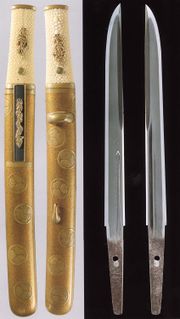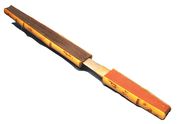Tantō

A tantō (短刀, "short sword") is a common Japanese single- or double-edged knife or dagger with a blade length between 15 and 30 cm (6-12 inches). The tantō was designed primarily as a stabbing weapon, but the edge can be used for slashing as well. Tantō appeared in the Heian period, but these blades lacked aesthetic quality and were used purely as weapons. In the early Kamakura period high-quality artistic tantō began to appear. Tantō production increased greatly around the Muromachi period and then declined in the Shintō period. Consequently, Shintō-period tantō are quite rare. They regained popularity in the Shin-Shintō Period.
Tantō are generally forged in hira-zukuri, meaning that their sides have no ridge line and are nearly flat, unlike the shinogi-zukuri structure of a katana. Some tantō have particularly thick cross-sections for armor-piercing duty, and are called yoroidoshi.
Tantō were mostly carried by samurai, as commoners did not generally wear them. Women sometimes carried a small tantō called a kaiken in their obi primarily for self-defense.
It was sometimes worn as the shōtō in place of a wakizashi in a daishō, especially on the battlefield. Before the 16th century, it was common for a samurai to carry a tachi and a tantō as opposed to a katana and a wakizashi.
Contents |
History of Tantō in Japan
Heian to Muromachi

The tantō was invented partway through the Heian period, when it was mainly used as a weapon. With the beginning of the Kamakura period, tantō were forged to be more aesthetically pleasing, and hira and uchi-sori tantō were the most popular styles. Near the middle of the Kamakura period, more tantō artisans were seen, increasing the abundance of the weapon, and the kanmuri-otoshi style became prevalent in the cities of Kyoto and Yamato. Because of the style introduced by the tachi in the late Kamakura period, tantō began to be forged longer and wider. The introduction of the Hachiman faith became visible in the carvings in the tantō hilts around this time. The hamon (line of temper) is similar to that of the tachi, except for the absence of choji-midare, which is nioi and utsuri. Gunomi-midare and suguha are found to have taken its place. In Nambokucho, the tantō were forged to be up to forty centimeters as opposed to the normal one shaku (about thirty centimeters) length. The tantō blades became thinner between the uri and the omote, and widen between the ha and mune. At this point in time, two styles of hamon were prevalent: the older style, which was subtle and artistic, and the newer, more ostentatious style. With the beginning of the Muromachi period, constant fighting caused the mass production of blades, meaning that with higher demand, lower-quality blades were manufactured. Blades that were custom-forged still were of exceptional quality, but the average blade suffered greatly. As the end of the period neared, the average blade narrowed and the sori became shallow.
Momoyama to Early Edo Age

Approximately two hundred fifty years of peace accompanied the unification of Japan, in which there was little need for blades. With weapon smiths given this time, both the katana and wakizashi were invented, taking the place of the tantō and tachi as the most-used pair of weapons, and the number of tantō forged was severely decreased. The only tantō produced during this period of peace were copies of others from earlier eras.
Late Edo Age
There were still few tantō being forged during this period, and the ones that were forged reflected the work of the Kamakura, Nambokucho, or Muromachi eras. Suishinshi Masahide was a main contributor towards the forging of tantō during this age.
Meiji to present
Many tantō were forged before World War II, due to the restoration of the Emperor to power. Members of the Imperial Court began wearing the set of tachi and tantō once more, and the number of tantō in existence increased dramatically. However, later on, a restriction on sword forging caused the number of tantō being produced to fall very low.
Types of Tantō
Tantō occupy two main categories, Suguta Tantō and Koshirae Tantō:
Suguta Tantō
- Shinogi: This is not a true tantō, for it is usually created when a longer sword has been broken or cut. Tantō are seldom made in this form.
- Ken: This is also not truly a tantō, though it is often used and thought of as one. Ken were often used for Buddhist rituals, and could be made from yari (Japanese spearheads) that were broken or cut shorter. They were often given as offerings from sword smiths when they visited a temple. The hilt of the ken tantō may be found made with a vajra (double thunderbolt related to Buddhism).
- Kanmuri-otoshi: These tantō had a single edge and a flat back. They had a shingoni that extended to the tip of the blade and a groove running halfway up the blade. It was very similar to the unokubi style tantō.
- Kubikiri: Kubikiri are rare tantō with the sharpened blade on the inside curve rather than the outside. One interesting fact about kubikiri is that they have no point, making them difficult to use in battle and enshrouding the weapon in mystery. Kubikiri can be roughly translated to “head cutter”. According to one myth, they were carried by assistants into battle in order to remove the heads of the fallen enemies as trophies for the warriors to show off during the triumphant return from battle. There are other speculations existing about the kubikiri’s possible uses. Perhaps they were used by doctors or carried by high-ranking officials as a badge is worn today. They could also have been used for cutting charcoal or incense, or used as an artistic tool for pruning bonsai trees.
- Shobu: The shobu is a commonly found blade type that is very similar to the shinogi. It is sometimes found with a groove running halfway up the blade.
- Kogarasamaru: The kogarasamaru is a very rare blade type that appears to be a branch of the shinogi blade type. The front third of the blade is double-edged.
- Kissaki-moroha: The kissaki-moroha features an extremely long o-kissaki. This means that it is much longer than the one shaku length of the average tantō.
- Unokubi: The unokubi is an uncommon tantō that features a single sharpened edge and a flat back. There is normally a short, wide groove extending to the midway point on the blade.
- Hira: The hira is a tantō form with no shinogi and a mune. It is extremely common due to the simplicity of its design.
- Hochogata: The hochogata is a tantō form that is commonly described as a short, wide, hira. The hochogata was one of the tantō forms that Masamune (an ancient sword smith whose name has become legend) favored.
- Katakiriha: The katakiriha is a tantō form that has one side that is completely flat, while the other side turns at a sharp angle to create a chisel-shaped blade.
- Moroha: The moroha is a rare, double bladed tantō type that has a diamond-shaped cross-section. The blade tapers to a point and contains a shinogi that runs to the point.
Koshirae Tantō
- Aikuchi: The aikuchi is a tantō form where the fuchi is flush with the mouth of the saya. There is no tsuba on this form of tantō. Aikuchi normally have plain wood tsuka, and many forms of aikuchi have kashira that are made from animal horns.
- Hamidashi: The hamidashi is a tantō style that features a small tsuba.
- Kuaiken: The kuaiken is a generally short tantō that is commonly carried in aikuchi or shirasaya mounts. More women carry kuaiken than men do.
- "Kamikaze" tantō: The "kamikaze" tantō is no more than a shirasaya tantō that is normally carried in horn mountings.
Other
- Fan Tantō: The fan tantō is a common tantō with a blade entirely concealed within a fan-shaped scabbard. The blade was usually low quality, as this tantō was not designed to be a display piece, but rather a concealable dagger useful for self-defense. Many fan tantō were forged during the 19th and 20th centuries to rip off tourists.
- Yari Tantō: Japanese spearheads were often altered so that it became possible to mount them as tantō. Yari tantō were carried by women for self-defense, and by samurai to pierce armor. Unlike most blades, yari tantō had triangular cross-sections.
- Hachiwara: Hachiwara are not true tantō, because rather than in place of a blade they a flat iron bar, normally twelve to fifteen inches long, with a sharp hook on the end. They have been called “helmet breakers” and “sword breakers”. Their mounts were typically made of carved wood or carved cinnabar lacquer.
Another use of tantō blades is in modern tactical knives. Modern tantō have been made by knife makers Bob Lum, Phill Hartsfield, Ernest Emerson, Allen Elishewitz, Bob Terzuola, Strider Knives, Benchmade, Spyderco, Severtech, SOG Knives, and Cold Steel.[1] The Tantō design for these knives usually features a thick spine on the blade that goes from the tang to the tip for increased tip strength. The handle shape may be altered slightly to provide better control.
Use in martial arts
Tantō with blunt wooden or blunt plastic blades are used to practice martial arts. Versions with a blunt metal blade are used in more advanced training and in demonstrations. Martial arts that employ the tantō include:
- Aikido
- Aikijutsu
- Jissen Kobudo Jinenkan (Jinen Ryu Tantojutsu)
- Bujinkan Budo Taijutsu
- Genbukan Ninpo Taijutsu
- Jujutsu
- Koryu Bujutsu
- Ninjutsu
- Shorinji Kempo
- Modern Arnis (taking place of dagger)
Notes
References
See also
- Aikuchi
- Kodachi
- Wakizashi
- List of daggers
- Types of swords
|
|||||||||||||||||
|
|||||||||||||||||